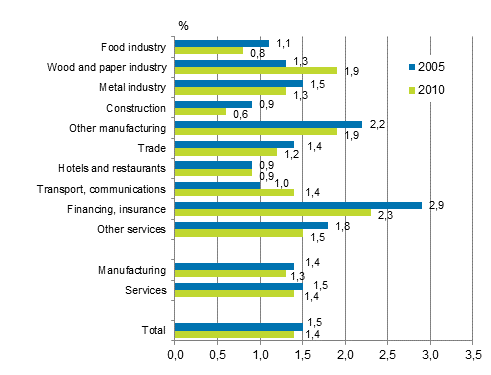Published: 17 April 2013
EUR 570 spent on course training per employee
Corrected on 25 March 2020. The corrections are indicated in red.
Enterprises spent, on average, EUR 573 per employee on course training. The sum is ten per cent higher compared to 2005, but if the changes in the level of costs are taken into account, the investment of enterprises in course training per employee has actually decreased to some degree in real terms 1) . In 2010, the share of training costs of labour costs was 1.4 per cent in Finland, which was 0.1 percentage points lower than in 2005 when the data were last collected.
The share of training costs of labour costs was slightly lower in manufacturing industries than in service industries but correspondingly the costs per employee were slightly higher than in service industries.
Share of course training costs (%) of labour costs in 2005 and 2010. The figure was corrected on 25 March 2020.

One should note that the costs were only collected for course training because most enterprises have a monitoring system for training days and costs. Participation in other forms of training (release from 28 November 2012) has increased somewhat from 2005, so in fact, the investments in personnel training are probably at least at the previously prevailed level as a whole.
The costs per employee grow in accordance with the size of the enterprise, just as the share of participants in the training. However, the investment per training participant does not vary much depending on the size of the enterprise.
The investment per participant in private sector enterprises was EUR 1,425, in 2010. Industry-specific fluctuations are, however, large, varying from EUR 630 per participant in the hotel and restaurant industry to EUR 2,400 in the financing and insurance industry (Appendix table 1.) Industries vary considerably in terms of occupational and personnel structure and the amount and quality of training needs also vary.
The biggest cost item is wages and salaries paid during periods of training
The cost structure of course training has remained relatively unchanged. The single biggest cost item is wages and salaries paid during periods of training and the fees and payments made to external training organisations form the second biggest cost item by far. In 2010, the wages and salaries paid during periods of training represented 47.6 per cent (+0.9% from 2005) and the fees and payments made to external training organisations 36.3 per cent (+0.1%) of training costs (Appendix table 2.) Compared to the situation in 1999, the share of fees in overall costs has increased by a few percentage points.
The survey covers enterprises in the private sector with at least ten employees in 2010, excluding agriculture and forestry, education, and health and social work. Finland's response data contains 1,560 enterprises that represent a total of 16,380 enterprises and their 1,150,000 employees. The survey was conducted in the same form in 32 European countries.
The survey is conducted approximately every fifth year and it is used to describe employer-sponsored training, the numbers of participants in course training, and the number of personnel training days received, the content and arrangers of the training, as well as the costs incurred from the training. The survey also examines other training formats apart from course training, enterprises' training strategies and the obstacles for organising training.
1) The Cost-of-living Index increased by 9.8 per cent from 2005 to 2010 but labour costs increased by 19.1 per cent in the corresponding period according to the Index of wage and salary earnings.
Source: CVTS, Continuing vocational training survey, Statistics Finland
Inquiries: Hannu Virtanen 09 1734 2514, Tarja Seppänen 09 1734 3220, cvts@stat.fi
Director in charge: Riitta Harala
Updated 17.4.2013
Official Statistics of Finland (OSF):
CVTS, Continuing vocational training [e-publication].
ISSN=1798-0003. Participation in course-format training 2010. Helsinki: Statistics Finland [referred: 26.12.2025].
Access method: http://stat.fi/til/cvts/2010/02/cvts_2010_02_2013-04-17_tie_001_en.html

